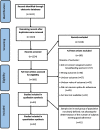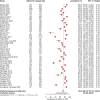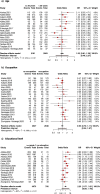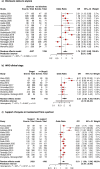Adherence to option B + antiretroviral therapy and associated factors in pregnant and breastfeeding women in Sub-Saharan Africa: a systematic review and meta-analysis
- PMID: 38183014
- PMCID: PMC10768427
- DOI: 10.1186/s12889-023-17004-9
Adherence to option B + antiretroviral therapy and associated factors in pregnant and breastfeeding women in Sub-Saharan Africa: a systematic review and meta-analysis
Abstract
Background: To assess the adherence to option B + antiretroviral therapy (ART) and associated factors in pregnant and breastfeeding women in Sub-Saharan Africa (SSA).
Methods: We conducted a comprehensive search from 01st January 2012 to 03rd October 2022, across four databases: PubMed, Scopus, Proquest Central, and Index Medicus Africain, to identify studies focused on pregnant and/or breastfeeding women living with HIV and receiving option B+ ART in SSA. Studies reporting adherence data were included in the meta-analysis. Were excluded studies published before 01st January 2012, grey literature, systematic reviews, and meta-analysis studies. Articles selection and data extraction were performed independently by two reviewers. We evaluated pooled adherence and pooled association between various factors and adherence using a random-effects model.
Results: Overall, 42 studies involving 15,158 participants across 15 countries contributed to the meta-analysis. The overall pooled adherence was 72.3% (95% CI: 68.2-76.1%). Having high education level (pooled odds ratio (OR): 2.25; 95% CI: 1.57-3.21), living in urban area (pooled OR: 1.75; 95% CI: 1.10-2.81), disclosing status to a family/partner (pooled OR: 1.74; 95% CI: 1.27-2.40), having a support system (pooled OR: 3.19; 95% CI: 1.89-5.36), receiving counseling (pooled OR: 3.97; 95% CI: 2.96-5.34), initiating ART at early clinical HIV stage (pooled OR: 2.22; 95% CI: 1.08-4.56), and having good knowledge on PMTCT/HIV (pooled OR: 2.71; 95% CI: 1.40-5.25) were factors significantly associated with adherence to option B + ART.
Conclusions: Despite the implementation of option B+ ART, the level of adherence among pregnant and breastfeeding women in SSA falls short of meeting the critical thresholds for viral load suppression as outlined in the 95-95-95 objectives set for 2025. These objectives are integral for achieving HIV elimination, and in turn, preventing HIV mother-to-child transmission. To bridge this gap, urgent tailored interventions based on individual and structural factors are essential to enhance adherence within these subgroups of women. This targeted approach is crucial in striving towards the HIV elimination target in SSA.
Keywords: Adherence; Antiretroviral therapy; Breastfeeding; Option B +; Pregnancy; Sub-Saharan Africa.
© 2024. The Author(s).
Conflict of interest statement
The authors declare no competing interests.
Figures







Similar articles
-
Medication adherence in pregnant women with human immunodeficiency virus receiving antiretroviral therapy in sub-Saharan Africa: a systematic review.BMC Public Health. 2018 Jun 27;18(1):805. doi: 10.1186/s12889-018-5651-y. BMC Public Health. 2018. PMID: 29945601 Free PMC article.
-
Sexual violence and antiretroviral adherence among women of reproductive age in African population-based surveys: the moderating role of the perinatal phase.J Int AIDS Soc. 2023 Jun;26(6):e26129. doi: 10.1002/jia2.26129. J Int AIDS Soc. 2023. PMID: 37306126 Free PMC article.
-
Mental health problems in pregnant and postpartum women living with HIV in sub-Saharan Africa: Systematic review and meta-analysis protocol.PLoS One. 2024 Oct 3;19(10):e0308810. doi: 10.1371/journal.pone.0308810. eCollection 2024. PLoS One. 2024. PMID: 39361676 Free PMC article.
-
Magnitude and risk factors of mother-to-child transmission of HIV among HIV-exposed infants after Option B+ implementation in Ethiopia: a systematic review and meta-analysis.AIDS Res Ther. 2024 Jun 7;21(1):39. doi: 10.1186/s12981-024-00623-6. AIDS Res Ther. 2024. PMID: 38849895 Free PMC article.
-
A meta-analysis of effectiveness of interventions to improve adherence in pregnant women receiving antiretroviral therapy in sub-Saharan Africa.Int J Infect Dis. 2018 Sep;74:71-82. doi: 10.1016/j.ijid.2018.07.004. Epub 2018 Jul 9. Int J Infect Dis. 2018. PMID: 30003952 Review.
Cited by
-
The price of progress: Assessing the financial costs of HIV/AIDS management in East Africa.Medicine (Baltimore). 2025 May 2;104(18):e42300. doi: 10.1097/MD.0000000000042300. Medicine (Baltimore). 2025. PMID: 40324279 Free PMC article. Review.
-
Effectiveness of a multi-component facility-based intervention on HIV-related infant and maternal outcomes: results from the IMPROVE clustered randomized study.Front Med (Lausanne). 2025 Apr 7;12:1521564. doi: 10.3389/fmed.2025.1521564. eCollection 2025. Front Med (Lausanne). 2025. PMID: 40259978 Free PMC article.
-
Developing an intervention to improve early infant HIV diagnosis service uptake among postpartum women in Malawi's primary healthcare using a co-designing approach with stakeholders.PLOS Glob Public Health. 2025 Apr 22;5(4):e0004426. doi: 10.1371/journal.pgph.0004426. eCollection 2025. PLOS Glob Public Health. 2025. PMID: 40261865 Free PMC article.
-
Incidence of loss to follow-up and associated factors among mothers on antiretroviral therapy in the context of elimination of mother-to-child transmission of HIV in two health districts of Bobo-Dioulasso in Burkina Faso.BMC Womens Health. 2025 Mar 29;25(1):148. doi: 10.1186/s12905-025-03658-7. BMC Womens Health. 2025. PMID: 40155888 Free PMC article.
-
Beyond HAART: unveiling the reality of antiretroviral therapy knowledge among pregnant women living with HIV in Kaduna State, Nigeria.Sci Rep. 2025 Apr 5;15(1):11711. doi: 10.1038/s41598-025-92745-8. Sci Rep. 2025. PMID: 40188143 Free PMC article.
References
-
- World Health Organization. Mother-to-child transmission of HIV. https://www.who.int/teams/global-hiv-hepatitis-and-stis-programmes/hiv/p.... Accessed 22 Nov 2022.
-
- UNAIDS. 2015 progress report on the global plan: toward the elimination of new infections among children and keeping their mothers alive. 2015. Available on: https://www.who.int/teams/global-hiv-hepatitis-and-stis-programmes/hiv/p.... Accessed 22 Nov 2022.
-
- UNAIDS. Women and girls carry the heaviest HIV burden in sub-Saharan Africa. Available on: https://www.unaids.org/en/resources/presscentre/featurestories/2022/marc.... Accessed 22 Nov 2022.
-
- UNICEF. Elimination of mother-to-child transmission: Progress in reducing new HIV infections among children has stagnated in recent years. 2023. Available on: https://data.unicef.org/topic/hivaids/emtct/. Accessed 9 Mar 2023.
-
- WHO/UNAIDS/UNICEF. The Global Alliance to end AIDS in children. Available on: https://www.unaids.org/sites/default/files/media_asset/global-alliance-e.... Accessed 9 Mar 2023.
Publication types
MeSH terms
Substances
LinkOut - more resources
Full Text Sources
Medical
Research Materials
Miscellaneous

